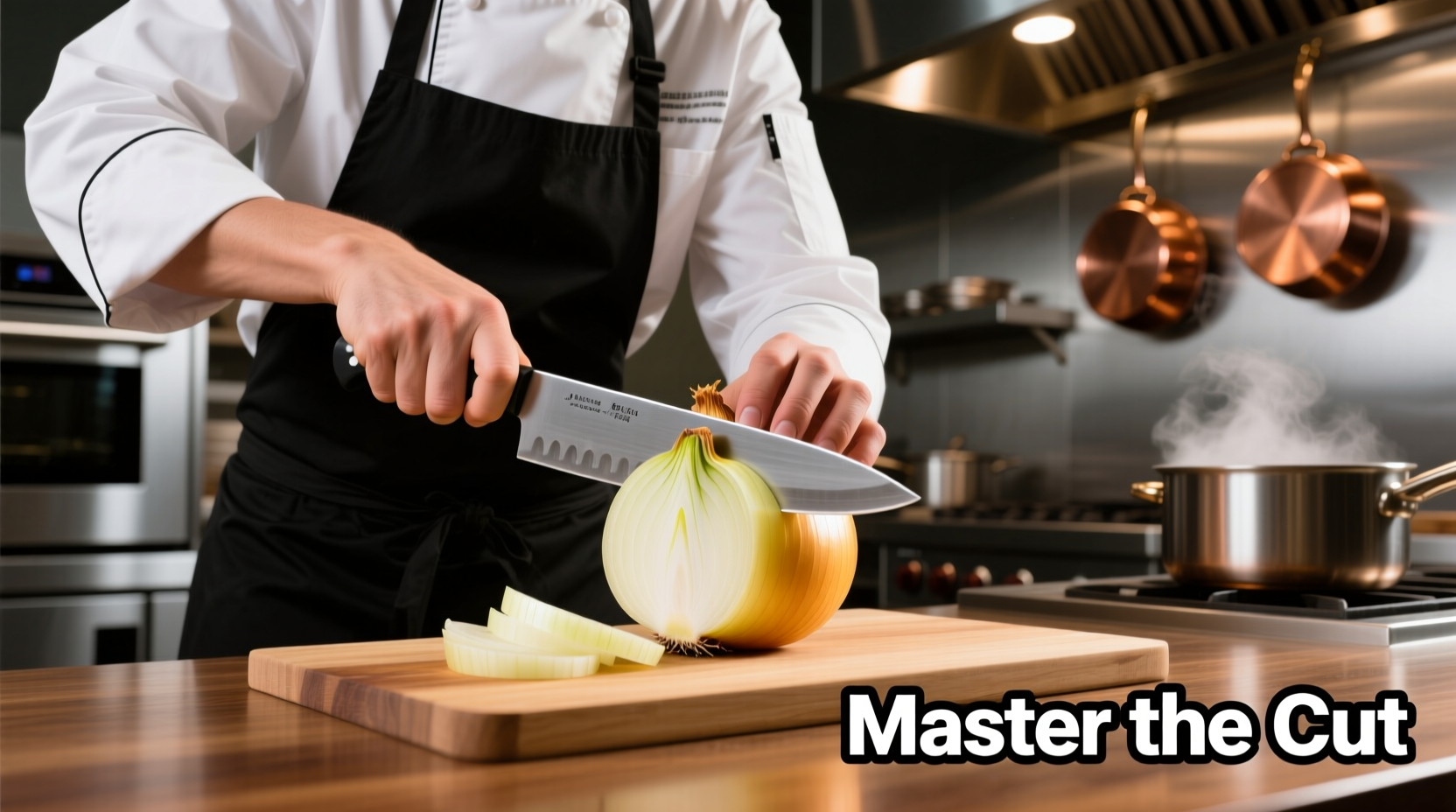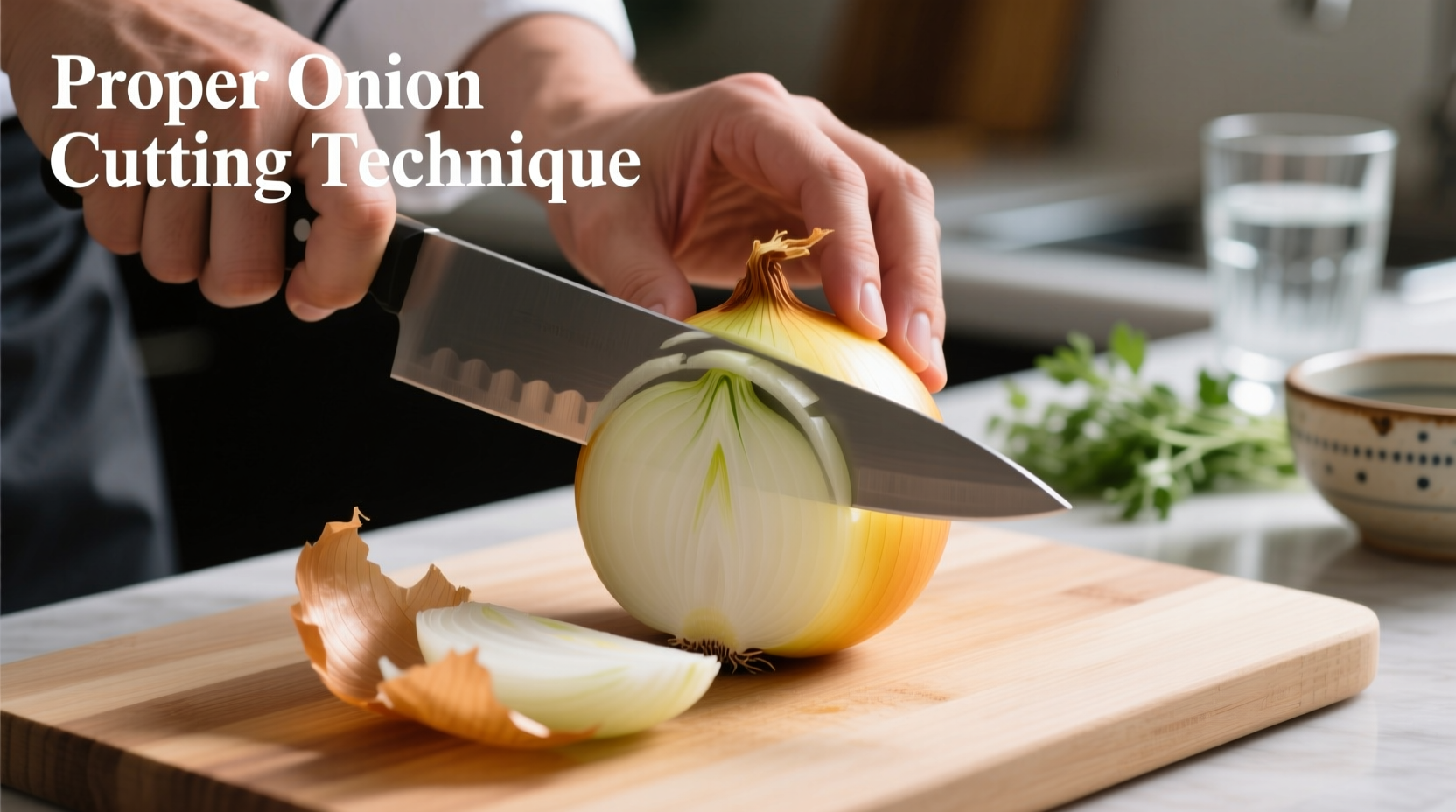Master the proper way to cut an onion in 6 steps: trim ends, peel, halve vertically, make horizontal cuts, slice vertically, and dice. This technique ensures safety, consistency, and minimizes tears while maximizing flavor preservation.
Ever wondered why professional chefs seem to handle onions with such ease while you're reaching for tissues? The proper way to cut an onion isn't just about speed—it's about precision, safety, and understanding the science behind those tear-inducing compounds. Whether you're preparing a simple salad or crafting a complex sauce, mastering this fundamental kitchen skill transforms your cooking experience from frustrating to flawless.
Why Proper Onion Cutting Technique Matters
Onions contain syn-propanethial-S-oxide, a volatile compound released when cells are damaged. The proper cutting technique minimizes this release while ensuring uniform pieces that cook evenly. According to the FDA Food Code, consistent vegetable preparation also promotes food safety by ensuring even cooking temperatures.
| Technique | Best For | Tear Reduction | Consistency |
|---|---|---|---|
| Vertical Halving Method | Sauces, soups, sautés | ★★★★☆ | ★★★★★ |
| Horizontal Slicing First | Grilled onions, sandwiches | ★★☆☆☆ | ★★★☆☆ |
| "Chef's Dice" Method | Salsas, garnishes | ★★★☆☆ | ★★★★☆ |
Your Step-by-Step Guide to Cutting Onions Like a Pro
Preparation: Setting Up for Success
Before you even touch your knife, gather these essentials:
- A sharp 8-inch chef's knife (dull knives crush cells, releasing more irritants)
- A stable cutting board (place a damp towel underneath to prevent slipping)
- Cold onions straight from the refrigerator (chilling slows enzyme activity)
- Proper hand positioning: "claw grip" with fingertips curled under

Safety First: Protecting Yourself and Your Ingredients
Food safety experts from the USDA Food Safety and Inspection Service emphasize that proper knife handling prevents both injuries and cross-contamination. Always cut away from your body, keep your workspace clear, and wash hands thoroughly after handling onions to prevent transferring irritants to your eyes.
The 6-Step Proper Onion Cutting Method
- Trim the ends: Remove 1/4 inch from both root and stem ends. Keep the root end intact until final cuts to maintain structural integrity.
- Peel efficiently: Score the papery skin with your knife tip, then remove in one motion. For stubborn skins, briefly submerge in cold water.
- Halve vertically: Cut from stem to root through the center. This preserves more cell structure than horizontal cuts.
- Make horizontal cuts: With the flat side down, make 2-3 shallow cuts parallel to the cutting board, stopping before reaching the root end.
- Slice vertically: Make thin, even slices from stem toward root, maintaining consistent spacing for uniform cooking.
- Dice precisely: Rock your knife through the slices at 90-degree angles for perfect cubes. Adjust spacing based on recipe requirements.
Avoiding Common Onion Cutting Mistakes
Even experienced home cooks make these errors that compromise both safety and results:
- Using a dull knife: Crushes cells rather than slicing cleanly, releasing more tear-inducing compounds
- Cutting horizontally first: Causes the onion to fall apart, creating uneven pieces
- Removing the root too early: Loses structural integrity, making controlled slicing impossible
- Rushing the process: Leads to inconsistent sizes that cook unevenly
Advanced Techniques for Specific Culinary Applications
Different dishes require different cuts. Understanding when to apply each technique elevates your cooking:
- Julienne (matchstick) cuts: Ideal for stir-fries where quick, even cooking is essential
- Concassé (coarse chop): Perfect for stocks and sauces where texture matters less than flavor extraction
- Thin crescents: Best for caramelizing, as the curved shape creates varied textures
- Fine mince: Essential for salsas and dressings where uniform flavor distribution is critical
Preserving Your Cut Onions
According to research from the National Center for Home Food Preservation, properly stored cut onions maintain quality for 7-10 days. Follow these storage guidelines:
- Use airtight containers to prevent odor transfer
- Place a paper towel in the container to absorb excess moisture
- Store in the refrigerator at 40°F or below
- Never freeze raw cut onions—they become mushy when thawed
Pro Tips for Tear-Free Onion Cutting
While no method eliminates tears completely, these evidence-based techniques significantly reduce discomfort:
- Cut near running water or under a vent to disperse volatile compounds
- Use a very sharp knife to minimize cell damage
- Cut the root end last—this part contains the highest concentration of enzymes
- Chill onions for 30 minutes before cutting to slow chemical reactions
- Wear kitchen-safe goggles for particularly pungent varieties
Frequently Asked Questions
How can I prevent crying when cutting onions without special equipment?
Chill onions for 30 minutes before cutting, use a sharp knife, and cut near a running faucet. The cold temperature slows enzyme activity while the water stream helps disperse the volatile compounds. Cutting the root end last also minimizes tear production since this part contains the highest concentration of irritants.
What's the difference between dicing and mincing onions?
Dicing creates uniform 1/4 to 1/2 inch cubes ideal for even cooking in soups and stews, while mincing produces very fine 1/8 inch or smaller pieces that distribute flavor throughout dishes like salsas and dressings. The proper cutting technique for mincing requires additional vertical cuts before the final rocking motion.
How long do cut onions stay fresh in the refrigerator?
Properly stored in an airtight container with a paper towel to absorb moisture, cut onions maintain quality for 7-10 days in the refrigerator at 40°F or below. Discard if they develop slimy texture, strong odor, or discoloration beyond normal browning.
Why should I keep the root end intact while cutting onions?
The root end contains the highest concentration of the compounds that make you cry, but keeping it intact until the final cuts maintains the onion's structural integrity. This allows for controlled, uniform slicing and prevents the onion from falling apart during preparation.
What knife is best for cutting onions?
An 8-inch chef's knife with a sharp, straight edge works best for onion cutting. The length provides leverage for smooth rocking motions while the weight helps with precision. Always keep your knife properly sharpened—dull knives crush onion cells rather than slicing cleanly, releasing more tear-inducing compounds.











 浙公网安备
33010002000092号
浙公网安备
33010002000092号 浙B2-20120091-4
浙B2-20120091-4